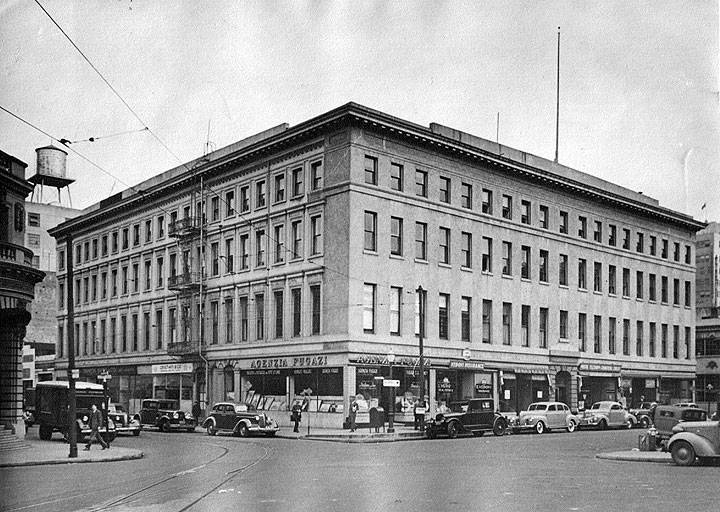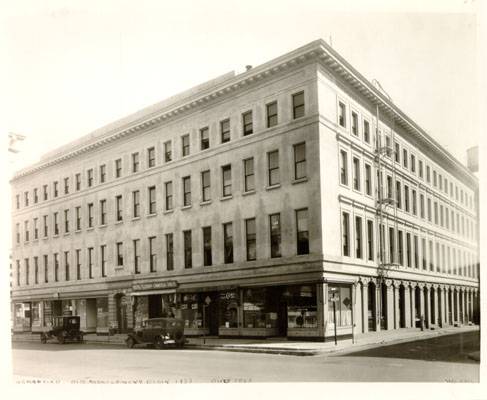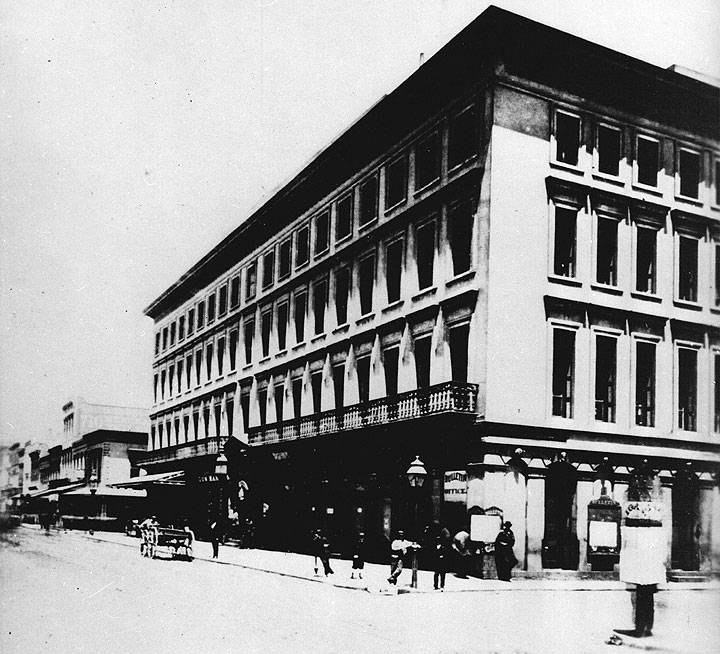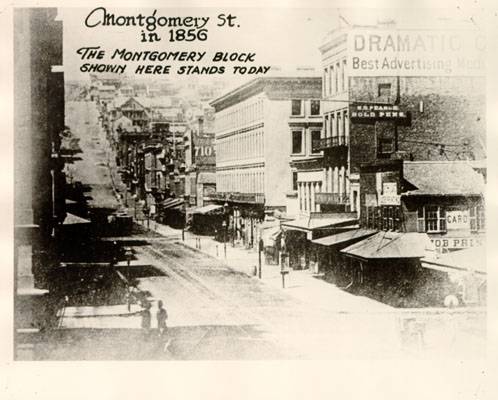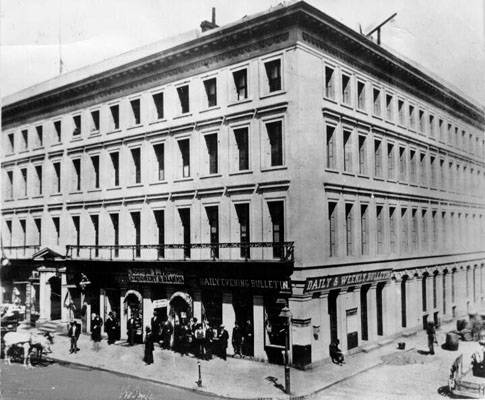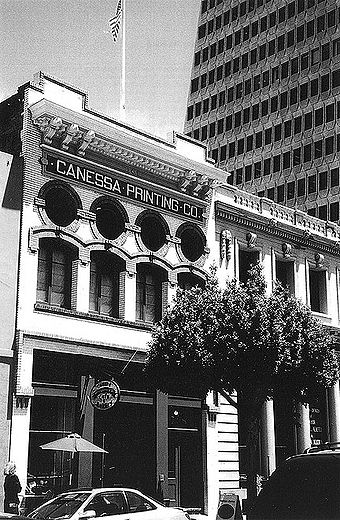The Monkey Block: Difference between revisions
(added two new photos) |
(added category buildings) |
||
| (One intermediate revision by the same user not shown) | |||
| Line 205: | Line 205: | ||
[[category:Public Art]] [[category:1930s]] [[category:North Beach]] [[category:Downtown]] [[category:1850s]] [[category:1950s]] [[ | [[category:Public Art]] [[category:1930s]] [[category:North Beach]] [[category:Downtown]] [[category:1850s]] [[category:1950s]] [[category: 1870s]] [[category:buildings]] | ||
Latest revision as of 14:29, 6 January 2013
Historical Essay
The Art Culture of the New Deal in the San Francisco Bay Area
by Harvey Smith, M.P.H.
Montgomery Block, 1930s
Photo: Courtesy of Jimmie Shein
The Montgomery Block in 1933.
Photo: San Francisco History Center, San Francisco Public Library
Works Progress Administration (WPA) artist Clay Spohn recalled working for the Federal Art Project (FAP) during the Great Depression saying, “I felt that I was doing [it] for the community, you know, and I felt sort of responsible, highly responsible as a matter of fact, for doing a good job because it was something you were sharing with others and it was for others... Everybody worked together, and you felt like a group, you know. You were contributing something to society as a whole.”1
The New Deal art programs in which Spohn participated produced a vast legacy of art that is still enjoyed today on public buildings and in museums, but the social milieu among the artists of the New Deal-sponsored programs rarely has been examined in detail.
The present dire economic crisis invites comparison with the Great Depression and calls for a reexamination of the legacy of New Deal social programs. This paper examines the rich culture and personal histories of a community of artists living and working in the vicinity of Montgomery Street in San Francisco that were part of an artistic renaissance nourished by federal arts programs from 1933-1943.
Like other New Deal programs that forged a new social contract with Americans and their government, the federal arts projects deeply affected the lives of the people they touched. Unprecedented government patronage not only enabled artists, writers, musicians, dancers and actors to productively survive the Depression, it encouraged collaboration, brought an array of free cultural programs to Americans for the first time, and forged a bond with the public through exhibitions, education programs and public performances. New Deal artists developed cooperative social and working relationships with one another and shared a sense of responsibility for bringing cultural programs to “Main Street” America rather than to elite patrons and collectors.
An understanding of the broader economic crisis of the time and the government’s response to it is needed to provide the context for the role these artists played in a well-considered and comprehensive program of public policy.
The Great Depression and the New Deal
In the 1920s, the economy was booming, but there was a wide gap in income between rich and poor Americans, just as now. Then the economic collapse began with the 1929 Stock Market Crash. The ensuing Great Depression left millions unemployed. There was no social safety net — no bank deposit insurance, no unemployment insurance, no social security.
Franklin Delano Roosevelt accepting the nomination of his party in 1932, pledged “a new deal for the American people.”2 Later he would state, “The test of our progress is not whether we add more to the abundance of those who have much; it is whether we provide enough for those who have too little.”3 This statement sums up the direction of the New Deal: Main Street before Wall Street. But then, just as now, the Right opposed Main Street progress.
People may argue over statistics about what the New Deal accomplished,4 but two things are needed to understand it clearly. First, that people who participated in or benefited from the New Deal tell the real, firsthand story, and second, that the New Deal’s physical legacy still surrounds us (mostly unrecognized) as buildings, bridges, roads, and public art — a visual landscape that we enjoy and depend on today.
In the first Hundred Days of FDR’s Administration fifteen major pieces of legislation were passed to address the problems created by the economic collapse.5 Among this so-called alphabet soup of programs was the Civilian Conservation Corps (CCC), ultimately employing 3.5 million unemployed youth and planting 3 billion trees. Another program gave long term mortgage loans(6) to some 1 million homeowners to prevent foreclosure. The Glass-Steagall Act separated commercial and investment banking and established the Federal Deposit Insurance Corporation (FDIC) to insure customers’ deposits in banks and thrift institutions up to $100,000. The Public Works Administration (PWA) built massive infrastructure projects, such as dams, bridges and schools.
After the Hundred Days, a myriad of other federal programs was created. Because regulating corporate excesses was critical, the Securities and Exchange Commission (SEC) was established to oversee stock market trading. The Federal Communications Commission (FCC) was formed to maintain electronic communications in the public interest.
Thousands of families were provided housing in both urban and rural areas.7 One of these programs, the Farm Security Administration (FSA), also hired photographers, including Walker Evans, Dorothea Lange, Arthur Rothstein, Russell Lee, Gordon Parks and others to document the conditions of drought-stricken and financially ruined farm families.
Putting people to work in decent conditions and protecting them on the job were critical. The National Youth Administration (NYA) hired high school and college students for work-study and part-time work and provided vocational training and programs for out-of-school youth. The National Labor Relations Act (NLRA), also known as the Wagner Act, gave workers the right to organize and bargain collectively with employers over working conditions, benefits, and wages. A crowning social policy achievement of the New Deal was the creation of the Social Security Administration.8 In addition to welfare provisions, it created a social insurance program for retired workers age 65 and older and provided for unemployment insurance.9
The first federal art program, the Public Works of Art Project (PWAP), was started in 1933. Later, the Treasury Department established two programs to decorate federal buildings by commissioning artists through a competitive process and by directly hiring artists on relief.10
Probably the best know New Deal program was established in 1935. The Works Progress Administration hired 8.5 million people and built thousands of schools, parks, city halls, public libraries, recreational fields, streets, highways, sewers, airports, utilities and more. The WPA/Federal Art Project included art, writing, theater, music and history projects, much of which celebrated the dignity of work and working people.11
FDR outlined his program for post-World War II in his 1944 State of the Union Address. He proposed a “second Bill of Rights” that recognized inherent human rights including employment, housing, medical care and education. FDR died before he could implement his “economic bill of rights” proposal.12 However, his New Deal programs did provide long-range public investment(13) which lifted communities all across the U.S. We are still benefitting from these infrastructure and social programs three quarters of a century later.
The Montgomery Block
Montgomery Block, 1870s.
Photo: Courtesy of Jimmie Shein
The Montgomery Block building seen here in 1856 stood where the Transamerica Pyramid stands today for more than century.
Photo: San Francisco History Center, San Francisco Public Library
In his oral history, archived at the Smithsonian Institution, WPA painter Clay Spohn described how he got “a studio on Montgomery Street in San Francisco where I could paint. My rent for the studio was paid and I had just enough money to eat on. So I’d go down there every day and work.”14
Built in 1853 as the largest commercial building west of the Mississippi, the huge brick Montgomery Block building served initially as studios and apartments for writers including Mark Twain, Bret Harte, Ambrose Bierce, Robert Louis Stevenson, Jack London, George Sterling, and Emma Goldman. The building miraculously survived the San Francisco earthquake and fire of 1906. By the 1930s, as many as 75 artists and writers had studios or apartments with rents as low as $5 per week in the building they had affectionately dubbed the “Monkey Block.”15 They and other artists were part of a lively arts scene that carried over into the bars and restaurants of the surrounding neighborhood.16 Luminaries such as Diego Rivera, Frida Kahlo, Ralph Stackpole, Maynard Dixon, Dorothea Lange, Benny Bufano and Sargent Johnson were part of this vibrant community which by the early 1930s epitomized the working relationships fostered by the federal government’s programs for the arts.17
The Montgomery Block building in 1880.
Photo: San Francisco History Center, San Francisco Public Library
Montgomery Street runs from the Financial District, passes Chinatown and North Beach, and ends at a cliff atop Telegraph Hill. It had been the heart of the Barbary Coast, the rough and ready center of the Gold Rush in San Francisco. Poet Kenneth Rexroth, known for inspiring the writers of the Beat Generation, and his artist wife Andree first came to San Francisco in the late 1920s. Rexroth described the bohemian community he found as “a tiny enclave in Italian North Beach in those days: a cooperative gallery that soon failed; a speak-easy; Isadore Gomez’s…; a restaurant, the Casa Beguine; the Montgomery block; a row of studios in the next block on Montgomery street; and a few shacks scattered among the dirt roads and goats on Telegraph Hill.”18
Sculptor Ruth Cravath described the scene as she found it in the 1930s, “the Montgomery Block had four floors. The first floor was offices. Artists had nothing to do with that… The Montgomery Block was a beautiful building. It had these sculptured heads around the outside… There was a big, open court… It was very good light for working… Every studio had two windows and some of [the studios] had running water and some didn't... We had a luxurious one. We had running water and…a little two-burner gas plate that we cooked on…”19
Its compactness was, in part, what galvanized this unique community of artists in contrast with the art scene in New York City. Artists in San Francisco were concentrated in an area of a few blocks and others lived in close proximity — living, working, eating, drinking and talking on a daily basis, both collaborating and influencing one another’s work. According to WPA artist Gertrude Goodrich who is still painting in New Jersey, during the 1930s and 1940s, most New York City artists lived in Greenwich Village lofts.20 WPA sculptor Milton Hebald, who lives and works near Los Angeles, described how other New Deal artists were spread out over the large metropolitan area of New York City, perhaps meeting weekly at the Artists’ Union.21
The Canessa Building, down the street from the Montgomery Block, also survived the 1906 earthquake and fire. Its website describes how “[i]n 1925, sculptor Ralph Stackpole and painter Timothy Wulff began work to turn the buildings at 716-718-720 Montgomery into artists’ studios. For the next 35 years, artists, including Diego Rivera, William Gerstle, Caroline Martin and Ruth Cravath, sculpted and painted in the “Ship Building,” so-named because a ship’s hull — historically thought to be the Georgian — is incorporated in the building…For 30 years, from 1933 to 1963, the Black Cat Cafe, located at 710 Montgomery, was the Canessa Building’s next door neighbor. In the 1930s and 1940s, the Cat attracted a bohemian clientele of both straight and gay writers, artists and musicians from the neighborhood. Many lived and worked across the street in the historic Montgomery Block building where the Transamerica Pyramid now stands.”22
Some of the artists saw their efforts tied to grassroots activism. Artists in San Francisco organized to get work and linked their work initially to labor organizing efforts, particularly the 1934 San Francisco General Strike. Bernard Zakheim, Kenneth Rexroth, Frank Triest, Victor Arnautoff and Ralph Stackpole were influential in forming the Artists’ and Writers’ Union to pressure Washington to initiate a federal art project.23 Their efforts resulted in the first New Deal mural project in the U.S. — Coit Tower on Telegraph Hill.24 This project, the combined work of 26 artists and their assistants, took place during the General Strike. The artists could see the labor actions unfolding on the Embarcadero below. Two strikers were killed by the police in the heated struggle. At one point the artist’s union organized a picket line around the tower to protect their murals from a vigilante committee attack.
Coincidentally, the last mural project would also be in San Francisco. The Rincon Annex Post Office murals begun by Anton Refregier in 1941 and completed after World War II were put “on trial” by a congressional subcommittee in the 1950s for their depictions of California history, but were ultimately spared from destruction.25
The Artists
The voices of New Deal artists who were part of the Monkey Block (found primarily in the mid-1960s oral histories of the Archives of American Art of the Smithsonian Institution) consistently depict the unique period of the 1930s and early 1940s and the experiences of working under government sponsorship. A common theme in these oral histories is the artists’ gratitude for the New Deal art programs that helped them to develop as artists, enabled them to form a supportive community, fostered their sense of responsibility to their public audience, and nurtured an American artistic renaissance.
Paul Carey, one of many artists interviewed by the Smithsonian, recalled working and learning with other artists. “[W]e drew from the model frequently(26) and had others [draw] with us at the studio, in the old Montgomery Block… 27 [T]he WPA, well, it’s the most unbelievable thing that I have ever heard of. They got seventy-five bucks a month and that was pretty good. They could live on it in a most modest sort of way. But it extended careers from art school into several years of further development, further maturity.”28
Sculptor Sargent Johnson said, “the [WPA was the] best thing that ever happened to me because it gave me more of an incentive to keep on working, where at the time things looked pretty dreary and I thought about getting out of it because, you know, I come from a family of people who thought all artists were drunkards and everything else. I thought I’d given it up at one time but I think the WPA helped me to stay… We could employ other artists too, people who were studying, who wanted to get a chance at doing something in that field.”29
Edith Hamlin, who was married to Maynard Dixon after his divorce from Dorothea Lange and collaborated with him on a mural project, recalled, “It was a busy period, altogether, and a very exciting period, with the Federal-sponsored murals… We all felt stimulated, and we felt lucky, too… 30 “I always count [the WPA] as the beginning, really, of my professional life as a muralist… I will always be grateful that I had the opportunity to be a part of it.”31
“[A]n angel descended on me,” is how Dong Kingman described the opportunity to work through the Federal Art Project. “I was assigned to the Watercolor Division of the Works Progress Administration…and for the next five years, I was able to concentrate on improving my watercolor technique, to think for myself, and to practice and develop my own style. And for the first time in my life, I had a studio of my own.”32 “Yes,” he continued, “the WPA project was the most wonderful thing that ever happened to one who is really enthusiastic about painting… My studio was right behind a café called The Black Cat, which is where all the characters hang out. If we had any discussion on art, we’d go around there and talk it over.”33
John Saccaro, a WPA painter and muralist, also recalled the scene at the Black Cat Cafe (34) as the place where all the artists would gather, talk and drink. He said, it “was a social thing and there was less competiveness. There wasn't this urge to make it big…”35
Mexican muralist Diego Rivera was a major artistic influence in San Francisco. He and his wife Frida Kahlo stayed in Ralph Stackpole’s studio when they first came to San Francisco in 1930. Rivera had come to paint a mural at the San Francisco Stock Exchange Club. Some local artists had previously visited Rivera in Mexico City, and others were certainly influenced by the extensive public work of the three famous Mexican muralists – Rivera, Orozco and Siqueiros. Rivera and Kahlo made quite an impression on the local artists, and one writer wrote a short story about them referring to her as the “Queen of Montgomery Street.”
Rivera’s assistant Emmy Lou Packard, who had a studio next to the Montgomery Block, said, “I have the feeling in talking to people who were on WPA in all parts of the country that they look back upon this as really the most rewarding time of their lives. I feel, and they seem to agree, that this was a time when they all had something in common and they were all working, paid a minimum salary, but nevertheless they were able to live on it, since things were pretty cheap in those days, rent and food and so on…So all of these artists had a feeling of community. They felt they were together…it’s a period I think we would do well to repeat.”37
Herman Volz, WPA supervisor and muralist, described his efforts to organize the artists. “Friends of mine from L.A. came up and asked me to help organize the American Artists Congress. And I agreed if they would help me organize an artists union… We had a wonderful cohesion with us really. I would think that the period when we were on the WPA was one of the nicest periods I have spent in America with artists. There was a friendship there, there was a kind of a direction everybody went… I think I grew tremendously. I would never have missed it. [The WPA period] was the most wonderful time I had in my life. It was a great time for me, all the way around. And I know for others too. I've seen men growing out of nothing into artists, you know… It was very exciting…”
Regarding federal support for the arts, Volz added: “Without subsidy, culture has a very difficult chance to grow… [T]he subsidies through the WPA project were a real upheaval for our lives. It was a very important thing. We could learn, we could develop… I mean we recognized this at the time: the artist needs this formal subsidy to continue our desire of expressing ourselves… Well, I do think that our period in America of the WPA was a glorious period. I think it's one thing we don't have any more today…”38
What was it like to work for a New Deal government agency? Dorothea Lange, the most famous photographer of the period as a result of her work documenting migrant farm workers, was an early resident of a studio next to the Montgomery Block. She explained the sense of responsibility she and her fellow workers at the Farm Security Administration maintained. “When you went into that office…you were so welcome, they were so glad to see you; did you have a good trip, was everything all right? What you were doing was important. You were important…[w]hich made you feel that you had a responsibility. Not to those people in the office, but in general. …[A] person expands when he has an important thing to do. You felt it… You found your way, but never like a big-shot photographer… We used our hunches, we lived, and it was hard, hard living. It wasn't easy, rather rough, not too faraway from the people we [were] working with… Now if they asked who you were, and they heard you were a representative of the government, who was interested in their difficulties, or in their condition, it's a very different thing from going in and saying, "I'm working for Look magazine, who wants to take pictures of you."… We photographers were somewhat picked at random, we weren't hand-picked. We were educated on the job. The United States Government gave us a magnificent education, every one of us. And I don't know any that's really fallen by the wayside…”39
Helen Bruton, known for her mosaic murals, also described that sense of responsibility: “so many young artists were so thrilled at the opportunity to just get their teeth into a real project…that they were very earnest and very sincere about it… There may have been some boondogglers, but I feel that by far the greater proportion were enthusiastic over the opportunity that it gave them.”40
Anton Refregier, Rincon Annex Post Office muralist, described how “[a]fter the Wall Street crash, with the great suffering of the people, the people had to be provided for… 41 It was a great time to be constantly nourished by the new ideas. But they were not new things in the form of the sensationalism we experience today. The wonderful, young guys coming up with powerful art forms, with powerful ideas, and so there was a kind of a competition. Like in Renaissance Italy where suddenly somebody was doing something in Rome that challenged the Italian artists in some other community or city… The artists had complete freedom and that we were only starting when we left off.”42
Sculptor Benny Bufano, known to be outspoken, summed it up. “WPA/FAP has laid the foundation of a renaissance of art in America. It is the open sesame to a freer art and a more democratic use of the creations of the artist’s hand and brain. It has freed American art. No longer must the artist be forced into social associations where the lonely claim to attention is the individual’s financial means. Means that meant material with which to work – stodgy dinners where the humiliation of being lionized was the price of the meal. Meals where artists were assembled to “sing for their supper” – portraits of overstuffed children and lazy women the only means of an artist’s expression and survival… One couldn’t expect these “patrons” to like the Project. It interfered with their opportunity to buy things of enduring beauty for pittances, under the guise of “helping struggling artists.” …How can a cultural pattern be developed for America if art and the artists are subjugated to the whims and idiosyncrasies of a few overfed decadent merchant princes, carryovers from the days of feudalism?...WPA/FAP has been the hope of the greatest cultural renaissance in recent times. For the present we have steel, stone, and tools. We have the spirit of great men and great cities to move us. We are busy.”43
The Legacy of the Montgomery Block
The climax to the New Deal artistic endeavor in San Francisco was the building of the 1939 World’s Fair on Treasure Island, a PWA project. Officially titled the Golden Gate International Exposition, but also known as the “Pageant of the Pacific,” it brought artists together to embellish the fairgrounds. When the fair was extended into 1940, the Art in Action project brought Diego Rivera and the WPA artists in direct contact with the public. By December 1941, all that the fair had tried to accomplish by showcasing the cultural diversity and unity of the Pacific Basin came to a horrible end with the attack on Pearl Harbor.
Lamentably, the lack of a strong preservation movement allowed the Montgomery Block building to be torn down two decades later in 1959. San Francisco poet Lawrence Ferlinghetti argued in 1998 “that North Beach… be officially protected as a "historic district", in the manner of the French Quarter in New Orleans, and thus shielded from commercial destruction such as was suffered by the classic old Montgomery Block building, the most famous literary and artistic structure in the West until it was replaced by the Transamerica Pyramid.”44 However, it is probably fitting and somewhat ironic that the site that housed generations of San Francisco writers and artists came to be occupied by San Francisco’s tallest and most iconic building.
Still very much in place is the essential infrastructure left by the New Deal. The true measure of a civilization is always more than its bricks and mortar, but its lasting cultural and artistic achievements. New Deal artists left a vast visual legacy of easel works, embellished buildings, sculpture and murals. The San Francisco Bay Area certainly received its share.
The Long View of the New Deal
Soon after FDR’s death in 1945, political attacks on the New Deal heightened. Three key areas were affected by New Deal deregulation: labor, media and finance. The National Labor Relations Act was initially weakened in 1947 by the Taft-Hartley Act; this has yet to be countered by an Employee Free Choice Act. Beginning in the 1980s, a weakened FCC allowed the current monopolization of the media. Many economists, including Nobel Prize winners Paul Krugman and Joseph Stiglitz and former Secretary of Labor Robert Reich cite the 1999 dismantling of the Glass-Steagall Act as a primary cause of the 2008 financial meltdown.46
The New Deal was clearly the result of the combination of intelligent and inspired leadership at the top and public discourse, enormous activism and unparalleled creativity at the grassroots. It established a new social contract that raised American middle-class living and cultural standards. Today we should ask the question, “Where did it go?”47 Reflecting on the scope of New Deal programs shows how much the vast majority of ordinary Americans has lost, and how we could revive the movement toward greater social equity and economic democracy. And, perhaps foster another artistic renaissance as well.
Harvey Smith, M.P.H. is President of the National New Deal Preservation Association and Advisor to the California’s Living New Deal Project.
This paper has been presented at the Conference, “1935: The Reality and The Promise,” held at Hofstra University on April 7, 8, 9, 2011.
All rights for publication in either printed or electronic format are strictly reserved by Hofstra University pending the publication of a representative selection of papers presented at the Conference.
Special thanks to Mary McChesney, Rondal Partridge, Milton Hebald, Gertrude Goodrich, Beth Danysh, Julia Bergman, Ruth Zakheim, Masha Zakheim and Nathan Zakheim. Dedicated to the memory of Thomas Fleming, Toby Cole, Milt Wolff, Archie Green and Studs Terkel. Thanks to Gray Brechin and Susan Ives for their suggestions.
Contact information:
Harvey Smith - harveysmithberkeley@yahoo.com
National New Deal Preservation Association
California’s Living New Deal Project
NOTES
1. Oral history interview with Clay Spohn, 1964 Oct. 5 and 1965 Sept. 25, Archives of American Art, Smithsonian Institution.
2. Roosevelt, Franklin D. “Roosevelt’s Nomination Address,” Chicago, IL, July 2, 1932.
3. Roosevelt, Franklin D. “Second Inaugural Address,” January 20, 1937.
4. For a clear explanation of the economic impact of the New Deal, see Walker, Richard A. and Brechin, Gray, The Living New Deal: The Unsung Benefits of the New Deal for the United States and California, Institute for Research on Labor and Employment, University of California, Berkeley, Working Paper #220-10, August 1, 2010.
5. Alter, Jonathan. 2006. The Defining Moment: FDR’s Hundred Day and the Triumph of Hope. New York: Simon & Schuster, New York.
6. Refinancing was done through the Home Owners’ Loan Corporation (HOLC).
7. This was done under several agencies, including the Public Works Administration, US Housing Authority and Federal Housing Administration (FHA) in urban areas and through Homesteads, Resettlement Administration (RA) and Farm Security Administration (FSA) in rural areas.
8. Downey, Kirstin. 2009. The Woman Behind the New Deal: The Life of Frances Perkins, FDR’s Secretary of Labor and His Moral Conscience. New York: Doubleday.
9. Flynn, Kathy. 2008. The New Deal: A 75th Anniversary Celebration. Layton, UT: Gibbs Smith, Layton, UT.
10. The Section of Fine Arts of the Treasury Department (the Section) was established to decorate federal buildings by commissioning artists through a competitive process, and the Treasury Relief Art Project (TRAP) was established to decorate federal buildings by hiring artists on relief.
11. Taylor, Nick. 2008. American-Made - The Enduring Legacy of the WPA: When FDR Put the Nation to Work. New York: Bantam Books.
12. Sunstein, Cass. 2004. The Second Bill of Rights: FDR’s Unfinished Revolution & Why We Need It More Than Ever. New York: Basic Books.
13. Leighninger, Robert D. Jr. 2007. Long-Range Public Investment: The Forgotten Legacy of the New Deal. Columbia, SC: University of South Carolina Press.
14. Oral history interview with Clay Spohn, 1976 Jan. 9-Feb. 5, Archives of American Art, Smithsonian Institution.
15. Tussey Dan. No date. “Fireproof in SF,” Guidelines, Newsletter for San Francisco City Guides and Sponsors. Online – sfcityguides.org.
16. Jones, Idwal. 1951. Ark of Empire: San Francisco’s Montgomery Block. New York: Doubleday & Company.
17. Swope, Sally. 1984. The Montgomery Washington Tower: An Historical Site and its Artifacts. San Francisco: Swope Art Exhibition Services.
18. Rexroth, Kenneth. 1966. An Autobiographical Novel. New York: Doubleday & Company. p.365.
19. Ruth Cravath and Dorothy Wagner Puccinelli Cravat: Two San Francisco Artists and Their Conemporaries, 1920-1975, Regional Oral History Office, The Bancroft Library, University of California, Berkeley.
20. Goodrich, Gertrude. Telephone Interview, Jan. 30, 2011.
21. Hebald, Milton. Oral Interview, Jan. 9, 2011.
22. “History,” Canessa Gallery Artists Resource, Jackson Square, San Francisco. Online – canessagallery.wordpress.com.
23. Lee, Anthony W. 1999. Painting on the Left: Diego Rivera, Radical Politics, and San Francisco’s Public Murals. Berkeley: University of California Press.
24. Zakheim, Masha. 2009. Coit Tower, San Francisco: Its History and Art. San Francisco: Volcano Press.
25. Brechin, Gray. 1996. “Politics and Modernism: The Trial of the Rincon Annex Murals.” In Karlstrom, Paul J., On the Edge of America: California Modernist Art, 1900-1950. Berkeley: University of California Press.
26. See Freeman, Paul. 1992. The Rock Art Lithographs of Lala Eve Rivol. Novato, CA: LWL Consulting. This book recounts the incredible story of a young model, artist and resident of the Montgomery Block.
27. Oral history interview with Paul Carey and Stephanie Caloia, 1997 Oct. 26, Archives of American Art, Smithsonian Institution.
28. Oral history interview with Paul Carey, 1993 Dec. 3 and 28, Archives of American Art, Smithsonian Institution.
29. Oral history interview with Sargent Johnson, 1964 July 31, Archives of American Art, Smithsonian Institution.
30. Edith Hamlin: A California Artist, An Interview Conducted by Donald J. Hagerty, American Studies Program, UC Davis, 1981.
31. Oral history interview with Edith Hamlin and Dorothy Cravath, 1964 May 27, Archives of American Art, Smithsonian Institution.
32. Kingman, Dong and Kingman, Helena Kuo. 1980. Dong Kingman’s Watercolors. New York: Watson-Guptill Publications. p. 18.
33. Oral history interview with Dong Kingman, 1965 Jan 12, Archives of American Art, Smithsonian Institution.
34. Rondal Partridge, Dorothea Lange’s assistant and National Youth Administration photographer, visited the Montgomery Block area as a youth, but seemed to find the Black Cat Café a bit “intimidating.” He never entered, describing it as a “gloomy place.” Oral Interview, Jan. 5, 2011.
35. Oral history interview with John Saccaro and Terry St. John, 1974 April 30- Nov. 18, Archives of American Art, Smithsonian Institution.
36. Weatherwax, John M. 1930s. “The Queen of Montgomery Street,” manuscript. Archives of American Art, Smithsonian Institution.
37. Oral history interview with Emmy Lou Packard, 1964 May 11-12, Archives of American Art, Smithsonian Institution.
38. Oral history interview with Herman Volz, 1964 June 27, Archives of American Art, Smithsonian Institution.
39. Oral history interview with Herman Volz, 1964 June 27, Archives of American Art, Smithsonian Institution.
40. Oral history interview with Dorothea Lange, 1964 May 22, Archives of American Art, Smithsonian Institution.
41. Oral history interview with Helen Bruton, 1964 Dec. 4, Archives of American Art, Smithsonian Institution.
42. The government providing for people’s needs could raise the question how were these artistic programs, as well as all the other New Deal programs, paid for? Deficit spending enabled allocations for New Deal social, cultural and infrastructure projects. This spending was eventually paid for through tax revenue. It is worth remembering that carved into the granite façade of the Internal Revenue Service building in Washington, D.C. is the statement by Oliver Wendell Holmes, Jr., "Taxes are what we pay for civilized society." We, the American people, have paid for our schools, post office murals, libraries, parks and roads. Ultimately, reconsideration of the balance between progressive taxation and regressive taxation is the answer to the present dilemma of budget slashing, program defunding and the widest income gap since the late 1920s.
43. Oral history interview with Anton Refregier, 1964 Nov. 5, Archives of American Art, Smithsonian Institution.
44. Bufano, Beniamino Benvenuto. 1973. “For the Present We Are Busy” in Art for the Millions, edited by Francis V. O’Connor. Boston: New York Graphic Society, Boston. p.107-110.
45. Inaugural address delivered by Lawrence Ferlinghetti, San Francisco’s first Poet Laureate, at the San Francisco Public Library on Tuesday, October 13th, 1998.
46. New Deal murals were later to influence the development of the 1970s mural movement. See Knight, Cher Krause. 2008. Public Art: Theory, Practice and Populism. Malden, MA: Blackwell Publishing. p. 117-118.
47. Kuttner, Robert, “The Bubble Economy,” American Prospect, September 24, 2007.
Krugman, Paul, “The Gramm Connection,” The New York Times, March 29, 2008.
Stiglitz, Joseph E., “Capitalist Fools,” Vanity Fair, January 2009.
Reich, Robert, “Too Big to Fail: Why The Big Banks Should be Broken Up, But Why The White House and Congress Don’t Want To,” robertreich.blogspot.com, October 25, 2009.
47. Today we have the choice between the comprehensive and progressive public policies of government regulation and Main Street programs, or the neo-liberal policies of tax cuts, trickle-down economics, de-regulation, and privatization and diminution of the public sector. To avoid getting lost among the dueling economists and public policy analysts in our zany contemporary political climate, current proposals can be measured by utilizing a “New Deal yardstick,” i.e., knowledge of the breadth and depth of the New Deal public policy.

